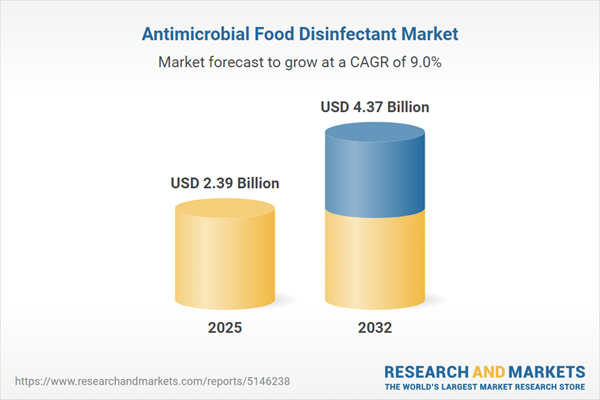Speak directly to the analyst to clarify any post sales queries you may have.
The antimicrobial food disinfectant market is experiencing accelerated transformation as food industry leaders strengthen safety protocols and adapt to heightened regulatory and consumer scrutiny. Innovative disinfection strategies now sit at the center of food supply chain integrity, with executives seeking proven solutions to minimize public health risks and maintain operational resilience.
Market Snapshot: Growth Trajectory of the Antimicrobial Food Disinfectant Market
The antimicrobial food disinfectant market grew from USD 2.19 billion in 2024 to USD 2.39 billion in 2025. It is projected to advance at a CAGR of 9.02%, reaching USD 4.37 billion by 2032. Strong market drivers include global food supply chain complexity, increasing consumer awareness of foodborne illness, and stringent regulations on hygiene management. Organizations are responding with advanced formulations, sustainable chemistries, and enhanced process controls to ensure product safety and maintain competitiveness.
Scope & Segmentation: In-Depth Coverage of Key Market Drivers
- Product Types: High expansion foams, low expansion foams, liquid concentrates, ready-to-use liquids, aerosol sprays, pump sprays, dry wipes, pre-soaked wipes.
- Active Ingredients: Chlorine-based, hydrogen peroxide, organic acids, peracetic acid, quaternary ammonium compounds.
- Applications: Equipment sanitation, packaging material disinfection, surface sanitation, wash water treatment.
- End Users: Food processing, foodservice, retail environments.
- Distribution Channels: Direct sales, distributor networks, e-commerce platforms.
- Key Regions: Americas (North America, Latin America), Europe, Middle East & Africa (EMEA), Asia-Pacific (including China, India, Japan, Australia, South Korea, and more).
- Notable Companies: AgroFresh Solutions, Alpha Chemical Services, Beaumont Products, BioSafe Systems, Brady Companies, Microban International, Ecolab Inc., Marico Limited, Evonik Industries, Kemin Industries.
This coverage enables stakeholders to benchmark trends, target high-growth segments, and optimize market entry and product development decisions.
Key Takeaways for Senior Decision-Makers
- Technology integration, such as nanotechnology and digital automation, is transforming disinfection performance and compliance management within processing facilities.
- Sustainability is a strategic priority, driving the shift toward biodegradable actives and reduced-residue solutions that align with both environmental and operational standards.
- Regulatory oversight is intensifying, prompting closer collaboration between quality assurance, R&D, and regulatory teams to accelerate approvals and align with best practices globally.
- Regional dynamics shape innovation and deployment, with North America adopting automated systems, EMEA advancing rinse-free and recyclable solutions, and Asia-Pacific focusing on scalable, cost-effective offerings to suit a broad range of operational needs.
- Strategic partnerships are enhancing product innovation and market access. Integrated hardware-software solutions, turnkey sanitation programs, and digital training tools streamline procurement and user engagement.
- Procurement strategies increasingly involve diversified vendor networks and near-shoring to mitigate international supply risks and improve cost controls.
Tariff Impact: Navigating Cost Pressures and Supply Chain Adjustments
The introduction of new U.S. tariffs in 2025 is exerting upward pressure on raw material and operational expenses throughout the antimicrobial food disinfectant supply chain. Industry players are actively pursuing supply diversification, stockpiling of critical materials, and reformulation using domestic inputs to curb volatility. This evolving landscape requires close collaboration with trade associations and policy makers to advocate for essential hygiene supply exemptions and foster collective procurement strategies.
Methodology & Data Sources
The research methodology centers on a combination of primary interviews with industry executives, food safety professionals, and regulatory officials, corroborated by quantitative and qualitative analysis of secondary sources, such as technical publications and government releases. Rigorous validation, including peer review and triangulation, ensures robust and actionable market insights.
Why This Report Matters: Targeted Value for Strategic Leadership
- Delivers actionable segmentation for evaluating high-potential investment, partnership, and product opportunities across regions and formats.
- Empowers executive stakeholders to anticipate regulatory, operational, and technological shifts shaping food safety and brand reputation.
- Informs proactive risk mitigation measures for tariff-related disruptions and supply chain continuity planning.
Conclusion: Meeting Evolving Challenges in Food Safety
The antimicrobial food disinfectant market is evolving rapidly as food industry stakeholders pursue safety, sustainability, and operational excellence. Adopting integrated technologies, resilient sourcing strategies, and regionally adapted business models will help companies strengthen their market position and meet future food safety challenges with confidence.
Additional Product Information:
- Purchase of this report includes 1 year online access with quarterly updates.
- This report can be updated on request. Please contact our Customer Experience team using the Ask a Question widget on our website.
Table of Contents
3. Executive Summary
4. Market Overview
7. Cumulative Impact of Artificial Intelligence 2025
Companies Mentioned
The companies profiled in this Antimicrobial Food Disinfectant market report include:- AgroFresh Solutions, Inc.
- Alpha Chemical Services, Inc.
- Beaumont Products Inc.
- BioSafe Systems, LLC
- Brady Companies, LLC
- Microban International, Ltd.
- Ecolab Inc.
- Marico Limited
- Evonik Industries AG
- Kemin Industries, Inc.
Table Information
| Report Attribute | Details |
|---|---|
| No. of Pages | 187 |
| Published | November 2025 |
| Forecast Period | 2025 - 2032 |
| Estimated Market Value ( USD | $ 2.39 Billion |
| Forecasted Market Value ( USD | $ 4.37 Billion |
| Compound Annual Growth Rate | 9.0% |
| Regions Covered | Global |
| No. of Companies Mentioned | 11 |









